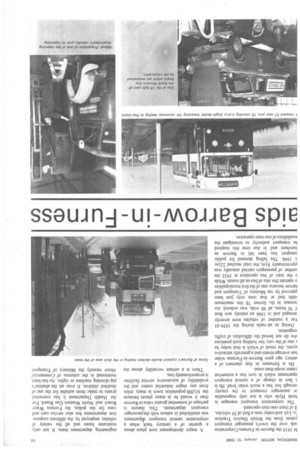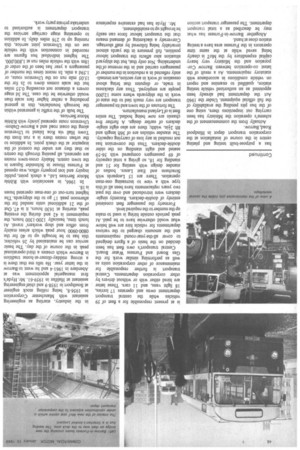Multi-purpose set-up aids Barrow-in-Furness
Page 46

Page 47

Page 48

If you've noticed an error in this article please click here to report it so we can fix it.
Corporation department covers passenger services, general municipal transport and MoT test facilities
by Ashley Taylor, AMIRTE, Assoc lnst T
N 1919 the Barrow-in-Furness Corporation Dok over the town's passenger transport ystem from the British Electric Traction 7o. Ltd. and today runs a fleet of 59 vehicles, 8 of them one-man-operated.
The corporation transport manager is )erek Hyde who is not only responsible Jr passenger transport in the county orough but has a much wider brief. He is -1 fact in charge of a central transport epartment which in turn has a somewhat reater scope than usual.
He is fortunate in that planners of a entury ago gave Barrow-in-Furness wider Inn average streets and a generally attractive iyout, the result of which is that today he one of the very few holding such positions uho do not bewail the difficulties of traffic ongestion.
Owing to air-raids during the 1939-45 Var a number of vehicles were severely amaged and in 1946 an entirely new fleet f 70 buses, all 811 wide, was ordered. An icrease in the former 711 6in. maximum fidth had at that time only just been pproved by tile Ministry of Transport and larrow became one of the first municipalities a operate this size of bus on all routes. While Lt the start of bus operation in 1932 the lumber of passengers carried annually was pproximately 8-4m, the total reached 221m a, 1948. The falling demand for public ransport has been felt in Barrow as lsewhere and in due time this inspired he transport authority to investigate the ■ ossibilities of one-man operation. A major development took place about a quarter of a century back when a corporation central transport department was established in unison with the passenger transport department. This feature is perhaps of somewhat greater value in B arrow than it would be in many places because the 65,000-population town is many miles from any major industrial centre and the availability of automotive service facilities is proportionately less.
There is a certain versatility about the
engineering department there. It not only maintains buses and all the variety of vehicles employed by the different corporation departments but also service cars and vans for the police, the Furness Water Board and North Western Gas Board. For the Health Department it has converted prams to make them suitable for the use of disabled children. It even set the abattoir's pig-skinning machine to rights. As has been mentioned in the columns of Commercial Motor recently the Ministry of Transport
has a purpose-built testing and plating centre in the course of installation at the corporation transport depot in Hindpool Road, Barrow.
Actually from the commencement of the scheme's operation the Ministry has been carrying out inspections there, using one of the bus pits pending the availability of the full official equipment. Under the 1960 Act the department had already been appointed as an authorized vehicle testing station, qualified to examine and report on vehicle conditions in accordance with statutory requirements. As a result of the latest co-operation between Barrow Corporation and the Ministry very heavy capital expenditure by the MoT is clearly being saved while at the same time operators in the Furness area have a testing station close at hand.
Altogether Barrow-in-Furness has what may be described as a total transport department. The passenger transport section is at present responsible for a fleet of 59 vehicles while the central transport department owns and operates 17 lorries, 18 light vans, and 11 cars. These latter are hired either with or without drivers by other corporation departments. Central transport is further responsible for maintenance of other corporation units as well as performing similar work for the Gas Board and Furness Water Board.
Central transport's own fleet has been decided on the basis of a figure designed to cover all-the-year-round requirements and the amounts charged to the various departments for vehicle hire are well below what would otherwise have to be paid. At peak periods outside hiring is used to make up the number to the required level.
Formerly the passenger fleet consisted entirely of double-deckers. Recently singledeckers were introduced and over the past two years replacements have been all of this type with a view to increasing one-man operation. There are 15 Leopards with Strachans and East Lancs. bodies of standee design with seating for 51 and standing for 18, so giving a total capacity of 69 passengers compared with 56-59 seated and eight standing on the older double-deckers. Thus the conversion has not resulted in any loss of carrying capacity. The standee vehicles are of 36ft length and 8ft 2-in. width; there are also eight singledeckers of earlier design. A further five chassis are now being bodied. The entire fleet is of Leyland manufacture.
The fortunes of the town and its passenger transport are very much tied to the state of work in the shipyards where some 12,000 people are employed. Thus any slackness in trade, or disputes that bring about cessation of work in any section, are immediately reflected in a reduction in the number of passengers carried and in the revenue of the undertaking. Not only that, but the shipyard situation also affects the transport labour position, full pressure in the yards almost invariably being followed by staff shortage. Conversely a slackening of demand means that the transport labour force can easily be brought up to establishment.
Mr. Hyde has had extensive experience in the industry, starting as engineering assistant with Manchester Corporation in 1956-8, being rolling stock engineer at Southport in 1958-9 and chief engineering assistant at Halifax in 1959-61. Mr. Hyde's first managerial appointment was at Aberdare in 1961-4 and he went to Barrow in the latter year. He tells me that there is a strong midday-dinner-at-home tradition in Barrow which creates a third operational peak in the course of the day. The basic service can be maintained by 26 vehicles; this has to be brought up to 40 for the 0800-0900 hour peak which arises mainly from office and shop workers' travel. At lunch time, basically 1200-1300 hours, the requirement is 42 and during the evening peak, starting at 1630 hours, it is 47. Out of the 21 additional units needed for the afternoon peak 17 go to the shipyards. The highest turn-out of one-man operated buses is 18.
In 1966, in association with Ribble Motor Services Ltd., a check point, public inquiry and lost property office, was opened at Furness House in Schneider Square in the town centre. Mainly cross-town routes are operated, all passing through the centre. so that they are under the control of the inspector at the check point. In addition to the urban routes there is a run from the Town Hall via Roa Island to Ulverston along the coast road and a Barrow-DaltonUlverston route operated jointly with Ribble Motor Services.
The bulk of the traffic is generated within the borough boundaries, this in general producing a rather higher fare scale than would otherwise be the case. The 3d stage covers a distance not exceeding 0.55 miles but the scale comes down to 2s for the 15.05 mile run on the Ulverston route, or 1.59d a mile. In recent times the number of passengers a year has been of the order of 18m with the vehicle miles run at 1,800,000. The highest individual bus figures are recorded in connection with the vehicle use on the Ulverston joint service, this running up to 276 miles daily. In addition to operating stage carriage services the transport department is authorized to undertake private party work.








































































































